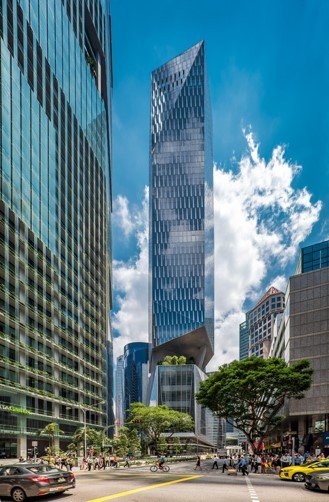
HIGH RISE FAÇADE – BALANCING AESTHETIC, STRUCTURAL INTEGRITY, AND FUNCTIONALITY
THURSDAY, MAY 16, 19:00-21:00 AT ROPPONGI MIDTOWN WORKSTYLING
LECTURE DESCRIPTION:
The façade of a high-rise building serves as both the face and the skin of the structure, embodying its aesthetic appeal while ensuring structural integrity and functionality. This presentation explores the intricate balance required in designing and implementing high-rise façades, where architectural vision meets engineering prowess. We explore the multifaceted considerations ranging from visual impact and environmental sustainability to structural stability and occupant comfort. Additionally, we examine innovative materials, technologies, and design strategies employed to achieve a harmonious synthesis of form and function in high-rise façades. Through case studies and examples, we illustrate the challenges and successes in achieving the delicate equilibrium between aesthetics, structural integrity, and functionality in the design and construction of high-rise façades.
Born in Kanagawa Prefecture in 1983. Worked at Bonhôte Zapata Architectes (Switzerland) from 2005 to 2006. Received the Swiss Federal Government Scholarship from 2006 to 2008. Graduated from the École Polytechnique Fédérale de Lausanne (EPFL) in 2008. Worked at HHF Architects (Switzerland) from 2008 to 2012. Established mnm in 2012. Assistant Professor at Tokyo University of Science (TUS) from 2015 to 2020. Special lecturer at TUS from 2020 to 2021. Visiting Professor at EPFL from 2022 to 2023. Adjunct Associate Professor at Columbia University in 2023.
LECTURER BIO:
Timothy Soebroto
Meinhardt Regional Director – South-East Asia
Timothy has been in the facade industry for over 25 years. He has been involved in diverse roles and positions in facade contractors, from designing to managing facade projects; including assisting architects in designing facade systems to achieve required aesthetic. He has an extensive experience in the designing and managing the facade systems, especially unitized curtain wall. His work experience include; Resorts World at Sentosa, Thamrin Nine Development, which will be the tallest building in southern hemisphere, NESCO Development and Ocean Prestige Tower in Mumbai, India and Saigon Bin Anh in Ho Chi Min City, Vietnam.
Brian Leung
Meinhardt Regional Director – North Asia
With more than fifteen years’ inclusive experience in curtain wall consultancy and contractor for both Hong Kong, Macau and PRC projects, Brian familiarized in full range of practice in Façade industry, he is not only proficiency in design and engineering for curtain wall, cladding and non-load bearing structural steel structure systems, but also the construction management and project statutory administration.
LEARNING OBJECTIVES:
Identify and describe the fundamental principles of high-rise façade design, including aesthetics, structural integrity and functionality.
Describe the structural analysis to assess the load-bearing capacity, wind resistance and seismic performance of high-rise façade systems.
Explore different façade materials in terms of their aesthetic qualities, durability and environmental impact.
Explore sustainable design strategies for high-rise facades, including passive design techniques, green materials and energy-efficient glazing systems.
THIS EVENT HAS BEEN APPROVED FOR 2 HSW CES UNITS.

Enoura Observatory at Odawara Art Foundation Visit
Join us for a special guided tour of the Enoura Observatory designed by Hiroshi Sugimoto at the Odawara Art Foundation. The tour will be lead in English by Museum Director Haruko Hoyle. Explore the stunning architecture in the beautiful surroundings. Earn CES points!
This tour will start in Tokyo at 9am and return to Tokyo around 6pm. We have chartered a small bus. Please wear comfortable walking shoes. For lunch we will stop for lunch at Suzuhiro Kamaboko Village where you can purchase food and omiyage.
More info about the Enoura Observatory and Odawara Art Foundation can be found here: https://www.odawara-af.com/en/
Schedule:
09:20 Meet at Shinagawa Station Kokuyo Building https://www.google.co.jp/maps/place/35°37'46.2%22N+139°44'35.4%22E/@35.629506,139.74317,17z/data=!3m1!4b1!4m4!3m3!8m2!3d35.629506!4d139.74317?entry=ttu
09:30 Depart by charter bus**
11:30 Lunch at Suzuhiro Kamaboko Village https://www.kamaboko.com/en/kamaboko_odawara/
13:30 Guided Tour
15:00 Explore on your own
16:25 Depart Enoura
18:00* Arrival Shinagawa
* Times may vary depending on traffic conditions.
** Bus seats are limited - priority will be given to AIAJ members.
Costs:
Bus: included in AIAJ membership
Museum Entry: 3000JPY per person collected on bus
Lunch: when we stop at the lunch spot, please purchase what you would like to eat
PHOTO USED BY PERMISSION BY THE ODAWARA ART FOUNDATION.

ebisu beer nite vol.3
Ebisu Beer Nite is back with a new name: ABC (Architects, Beer, and Chat)!
It’s another chance to meet fellow AIA Japan members and connect!
Pay for your own drink and food. Come anytime, leave anytime.
See you at the PUB TAP+ in Ebisu.

Gallery MA Guided Tour
Company Profile
Fuminori Nousaku and Mio Tsuneyama are Tokyo-based architects. They engage in critical architectural practice on the theme of contemporary cities and ecosystems.
Their representative works include Holes in the House (Tokyo,) House For Seven People*(Tokyo); Akeno Raised Floor** (Yamanashi Prefecture); Piles and Pointed Roof (Tokyo); Guest House in Takaoka*** (Toyama Prefecture); Himi Migrant Village (Toyama Prefecture); and ”House on Classical Elements” Smart Village in Akiya (Kanagawa Prefecture).
They received numerous awards including the 15th Venice Architecture Biennale Special Mention Award (for the Japanese Pavilion exhibition); the 33rd JIA Young Architect Award**; and the AIJ Selected Works Young Architect Award.***
* Mio Tsuneyama ** Fuminori Nousaku *** Fuminori Nousaku +Junpei Nousaku
All others works: Fuminori Nousaku + Mio Tsuneyama
Mio Tsuneyama, Architect
Born in Kanagawa Prefecture in 1983. Worked at Bonhôte Zapata Architectes (Switzerland) from 2005 to 2006. Received the Swiss Federal Government Scholarship from 2006 to 2008. Graduated from the École Polytechnique Fédérale de Lausanne (EPFL) in 2008. Worked at HHF Architects (Switzerland) from 2008 to 2012. Established mnm in 2012. Assistant Professor at Tokyo University of Science (TUS) from 2015 to 2020. Special lecturer at TUS from 2020 to 2021. Visiting Professor at EPFL from 2022 to 2023. Adjunct Associate Professor at Columbia University in 2023.
Fuminori Nousaku, Architect
Born in Toyama Prefecture in 1982. Graduated from Tokyo Institute of Technology (Tokyo Tech) in 2005 and completed the graduate program at Tokyo Tech in 2007. Worked at Njiric+ Arhitecti (Croatia) in 2008. He has been leading Fuminori Nousaku Architects since 2010. Obtained Ph.D. from Tokyo Tech in 2012. Assistant Professor at Tokyo Tech from 2012 to 2018. Associate Professor at Tokyo Denki University from 2018 to 2021. Adjunct Associate Professor at Columbia University in 2023. Currently Associate Professor at Tokyo Metropolitan University.
Exhibition Description
Nousaku and Tsuneyama have been researching the relationship between architecture, cities, and ecosystems at universities in Japan and abroad while designing architecture and writing articles. They have been renovating the “Holes in the House,“ their home and office, from an ecological viewpoint by drilling holes in the slabs of the existing steel frame house to circulate light and heat, breaking the concrete-covered exterior with their hands, and improving the soil. It is a place of implementation where they experiment and develop what they learned elsewhere into upcoming projects. They attempt to bring the wild back into the city based on their idea of "Urban Wild Ecology" and actively incorporate traditional knowledge of stone masonry and wood framing as well as materials that return to the soil, such as straw and earthen walls.
They refer to cities as "human-influenced habitats for diverse organisms. "It decomposes part of contemporary cities faced with challenges, absorbs their nutrients, and grows like a fungus (mushroom.) They see architecture as a nexus point in the mesh of such decay and regeneration while striving to establish multispecies networks by using the wild and traditional knowledge to cut into the mesh and reconnect them.
This exhibition is an attempt to share their small trials and errors that everyone can emulate to reconnect the mesh through cross-sectional drawings and models of projects, including the proposed further renovation of the "Holes in the House" and the latest, “House on Classical Elements” Smart Village in Akiya. We hope viewers will perceive the possibilities and visions of architecture in the age of Anthropocene beyond it.

MICHAEL ELIASON: LOW CARBON LIVING WITH CLIMATE ADAPTIVE ECODISTRICTS & BUILDINGS
The weather data for building envelopes and mechanical systems is based on historic averages that have been superseded by the last decade of Climate Change. These averages do not take into account wildly divergent peaks/extremes or the climate zone migration that is occurring with Climate Change. We are just beginning to see the extremes related to wildfires, flooding, and heat – and the impacts will be far reaching.
In 2014, the Supreme Court of California found that architects owe a duty of care to occupants and residents of buildings. The rapidly deteriorating weather due to climate change are affecting buildings in ways out-of-date energy models could never have predicted. Extended wildfire smoke events. Deluges dropping more water than roofs and drains can handle. Overheating due to poor design, which can become deadly during heat events on building configuration at 90 degrees Fahrenheit. Attendees will learn about building threats from climate change extremes, ways to mitigate them, and possibilities for reducing risks and liability as planners
Are your buildings and housing designed to adapt to climate change, or will it facilitate dangerous and potentially deadly outcomes for residents? Architects, developers, and owners will need to rapidly pivot to adapting to these new changes. This session will cover some of the threats involved with Climate Change, what strategies design teams and owners should be employing to adapt, and what the ethical liability and implications may be in a rapidly devolving climate.
Topic area: Building planning for extreme climate events: How building design today is not designed to mitigate and adapt to a wildly changing climate. Mitigating liability for practitioners by understanding how our buildings will perform in heat domes, cold snaps, wildfire smoke events, deluges – and migrating climate zones.





